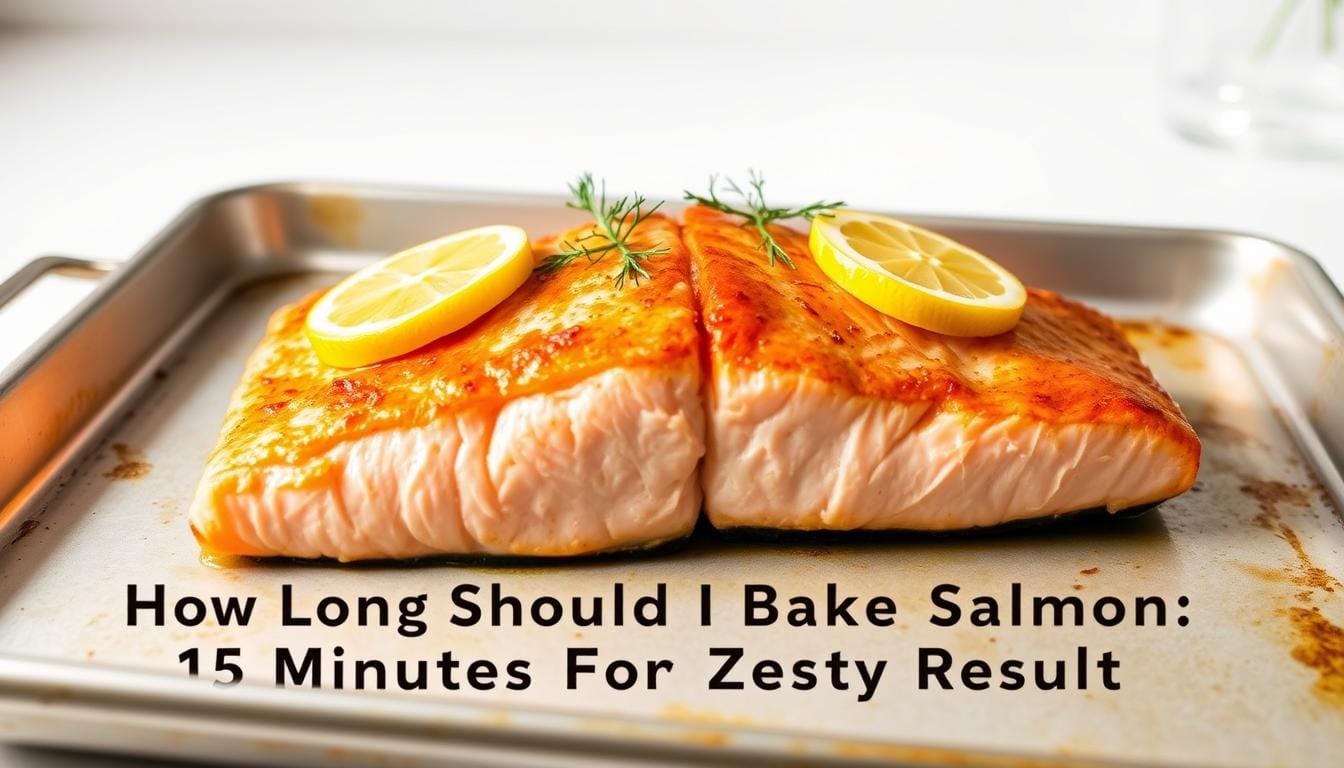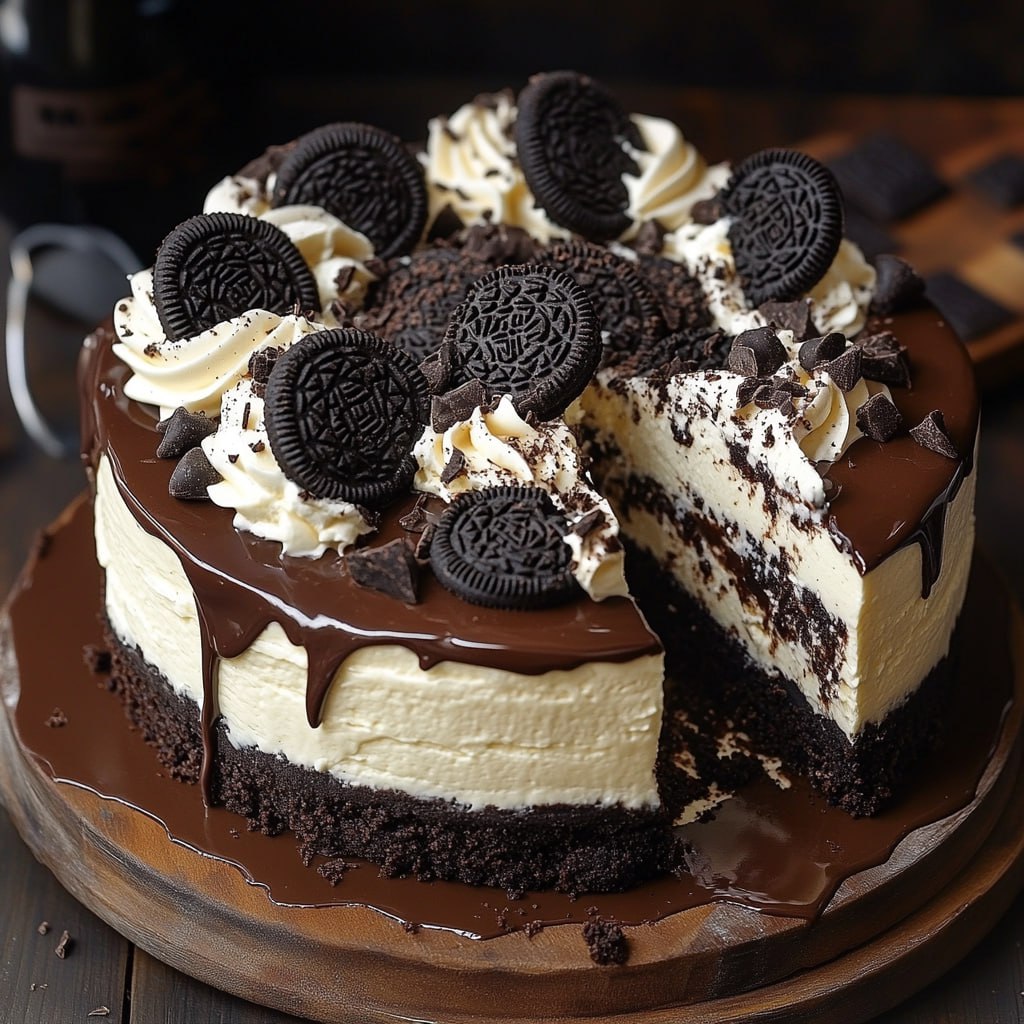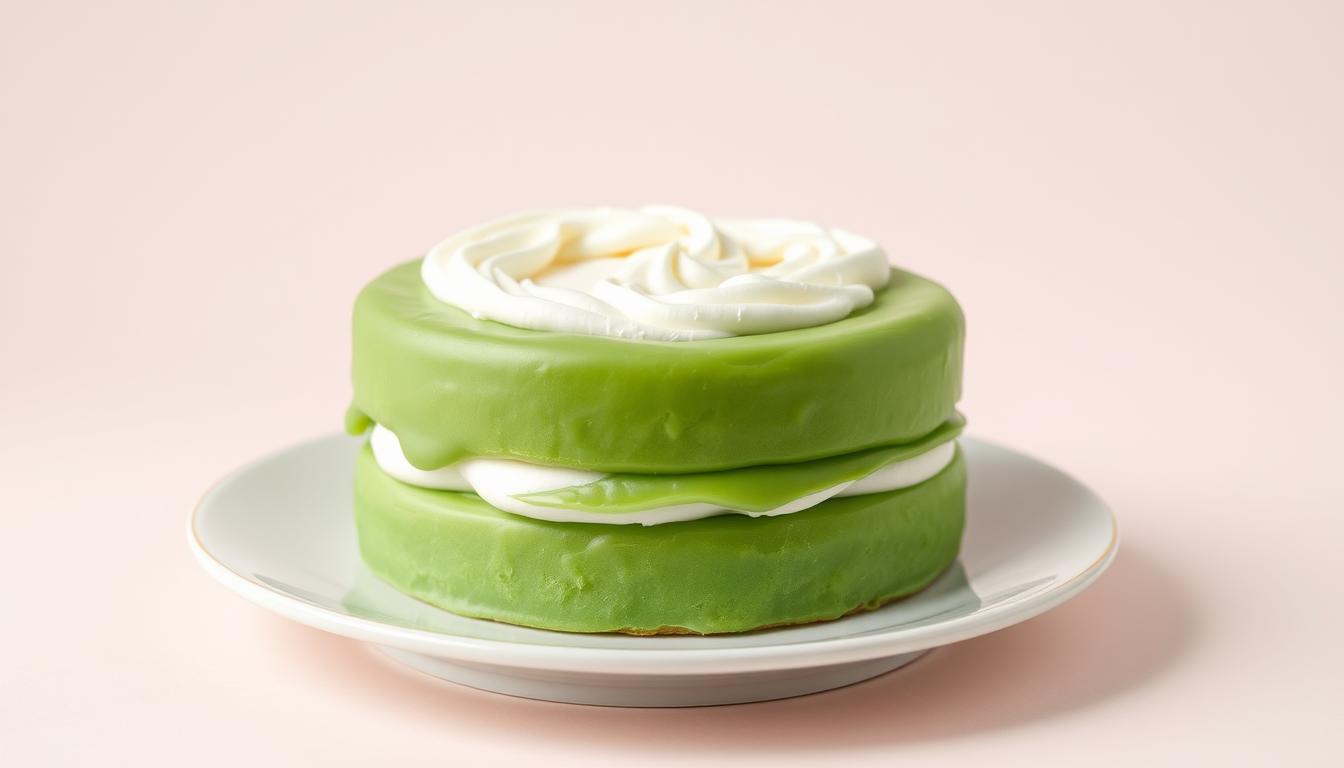Picture this: You’re craving a meal that’s wholesome, flavorful, and effortless to make—but your busy schedule has no time for elaborate prep. That’s where oven-baked salmon shines. If you’ve ever wondered how long should I bake salmon to get that perfect flaky texture, the answer might surprise you: just 15 minutes.
In this simple guide, we’ll show you how to transform everyday ingredients into tender, citrus-infused fillets that feel gourmet yet fit into your weeknight routine. From selecting fresh salmon to seasoning it with bright lemon and herbs, we’ll take you step-by-step through a foolproof process that delivers delicious results—every time.
Whether you’re new to seafood or just want a quicker, more reliable method, this tutorial eliminates the guesswork. You’ll learn expert oven tips that lock in moisture, plus easy storage tricks to keep leftovers tasting just as good the next day.
Let’s make your kitchen the best seafood spot in town—no reservations (or complicated tools) required.
Table of Contents
Key Takeaways
- 15 minutes in the oven delivers tender, flaky salmon with minimal effort
- Fresh lemon enhances flavor while keeping the dish light and bright
- Proper temperature control prevents overcooking and dryness
- Versatile seasoning options adapt to personal taste preferences
- Leftovers store beautifully for quick meals throughout the week
Overview of the Recipe and Its Benefits
Weeknight dinners just got a gourmet upgrade with this oven-roasted salmon. Its magic lies in balancing simplicity with nutritional power – think flaky, citrus-glazed fillets ready faster than takeout. Health experts praise salmon as a top source of omega-3s, which support heart health and brain function.
What makes this dish stand out? You get 21 grams of protein per serving with almost no saturated fat. The prep takes minutes: drizzle olive oil, add lemon slices, and season. No marinating or complex techniques required.
This method shines for both casual meals and dinner parties. Pair it with roasted asparagus for a light option or garlic mashed potatoes for comfort food vibes. Leftovers transform into salads or sandwiches, making it a smart choice for meal prep.
Fresh ingredients elevate results. Wild-caught fillets offer richer flavor, while quality sea salt enhances natural sweetness. Whether you choose dill or paprika, the seasoning adapts to your taste without compromising the dish’s integrity.
Essential Ingredients and Preparation
Great meals start with quality components. For this oven-roasted salmon recipe, every element plays a specific role in creating harmony on your plate. Let’s break down what you’ll need and how to prepare them for maximum impact.
Your Flavor Foundation
- Fresh salmon fillets (6-8 oz each, skin-on preferred)
- Cold-pressed extra virgin olive oil (California Olive Ranch recommended)
- Fresh garlic cloves (minced or thinly sliced)
- Coarse sea salt (Maldon or Jacobsen)
- Cracked black pepper
- Organic lemon (Meyer variety adds sweetness)
- Dried Italian herb blend (McCormick or Simply Organic)
Precision Preparation Steps
Pat fillets dry with paper towels – this helps seasoning stick better. Drizzle olive oil evenly across the fish’s surface. Rub minced garlic gently into the flesh, letting its aroma infuse the protein.
Combine salt, pepper, and herbs in a small bowl before sprinkling. This ensures even distribution. Place lemon slices beneath the fillet during cooking to steam subtle citrus notes upward.
Portion larger cuts into 1.5-inch wide pieces. Uniform sizing guarantees consistent cooking. Let seasoned fish rest 5 minutes before baking – this allows flavors to penetrate deeper.
Pro tip: Brushing oil directly on the baking sheet prevents sticking without overwhelming the dish’s natural taste. The garlic-herb mixture creates a flavorful crust while locking in moisture.
How Long Should I Bake Salmon
Mastering the art of cooking fish requires precision. For tender, flaky results, focus on two factors: heat intensity and protein thickness. Thinner cuts demand less oven exposure, while heartier portions need careful monitoring.
Timing Guidelines for Different Cuts
Standard fillets (1-inch thick) reach perfection at 400°F in 12-15 minutes. Check thicker pieces (1.5 inches) at 15 minutes—they might need 2-3 extra minutes. Whole sides or steaks require 15-18 minutes depending on bone content.
| Cut Type | Thickness | Oven Temp | Time Range |
|---|---|---|---|
| Fillet | 1 inch | 400°F | 12-15 min |
| Steak | 1.5 inches | 400°F | 15-18 min |
| Whole Side | 2 inches | 375°F | 18-22 min |
Watch for visual cues to know salmon done. The flesh turns opaque pink and separates easily with a fork. For exact results, use a meat thermometer—145°F indicates doneness without dryness.
Remember: residual heat continues cooking after removal from the oven. Pull fillets out when they reach 140°F internally. Let rest 3 minutes before serving for ideal texture.
Baking Techniques and Equipment
Your kitchen tools transform simple ingredients into culinary magic. The right setup ensures juicy, evenly cooked fillets every time. Let’s explore three popular methods and their impact on texture.
Material Matters: Foil vs. Parchment
Aluminum foil creates a steam pocket around your salmon piece, locking in moisture. It’s ideal for marinated fillets or citrus-heavy recipes. Parchment paper offers gentle heat circulation, preventing sticking without steaming.
| Method | Benefits | Best For |
|---|---|---|
| Foil | Traps juices, easy cleanup | Lemon-herb glazes |
| Parchment | Crispy edges, even browning | Skin-on fillets |
| Bare Pan | Direct heat exposure | Quick-roasted pieces |
Mastering Heat Distribution
Use a rimmed baking sheet to catch drips while allowing air flow. Position fillets 2 inches apart – overcrowding causes uneven cooking. For extra insurance, rotate the pan halfway through baking time.
Thicker cuts benefit from parchment-lined pans. The paper prevents scorching while letting heat penetrate evenly. Always pat fillets dry before seasoning. Moisture on the surface leads to steaming instead of roasting.
Pro tip: Combine methods for custom results. Try foil under parchment for marinated baked salmon needing crispy tops. Adjust based on your oven’s hot spots and the recipe’s moisture content.
Temperature and Cooking Time Insights
Heat control makes or breaks your salmon’s texture. Thinner cuts thrive at 400°F, while thicker sides need gentler 375°F roasting. This difference protects delicate flesh from drying out while ensuring thorough cooking.
The Science of Heat Distribution
Higher temperatures create a flavorful crust through the Maillard reaction. Lower settings allow gradual heat penetration. For individual fillets, 400°F achieves golden edges and moist centers in 12-15 minutes. Whole sides cooked at 375°F retain juiciness for 18-22 minutes.
Carryover cooking adds 5°F after removal from the oven. Pull fillets at 140°F internal temperature using a digital thermometer. Let them rest 3 minutes – residual heat completes the process without overcooking.
| Cut | Temperature | Outcome |
|---|---|---|
| Fillet | 400°F | Crispy skin, tender center |
| Steak | 390°F | Even doneness |
| Whole Side | 375°F | Uniform flakiness |
The fork test confirms doneness: flesh should separate easily but hold shape. USDA guidelines recommend 145°F, but removing fish earlier prevents dryness. Adjust based on your oven’s calibration and preferred texture.
Thicker pieces benefit from lower heat to avoid burnt exteriors. Always measure thickness at the center – this determines your best temperature choice. Pair these insights with proper resting time for foolproof results every time.
Enhancing Flavor with Citrus, Herbs, and Spices
Transform ordinary fillets into vibrant masterpieces with strategic flavor pairings. Bright citrus cuts through richness, while aromatic herbs add layers of complexity. This combination creates restaurant-quality taste without demanding chef-level skills.
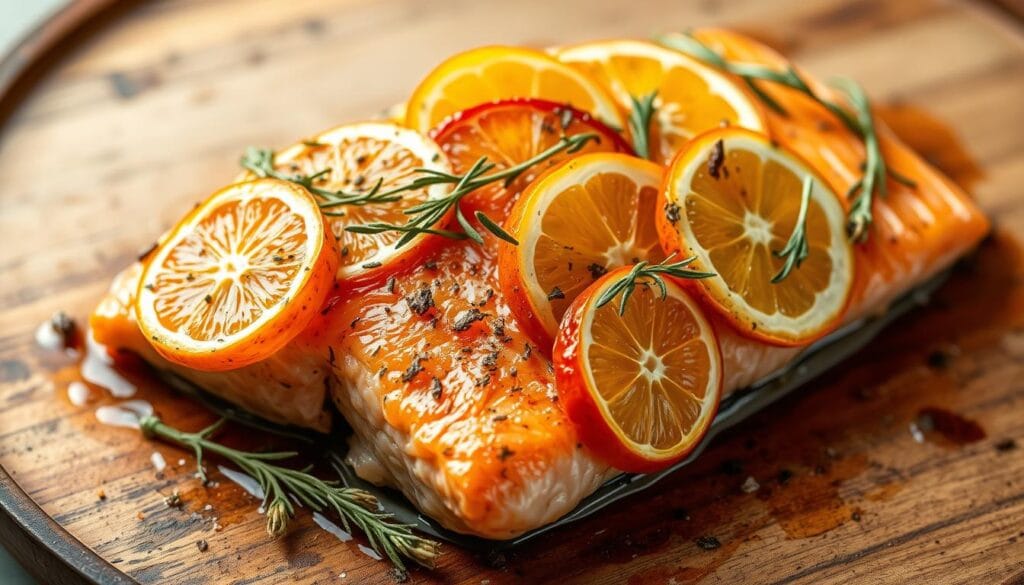
The Role of Lemon and Olive Oil
Fresh lemon juice acts as both marinade and finishing touch. Its acidity balances the fish’s natural oils, creating a cleaner palate. Drizzle olive oil first—it helps seasonings cling to the surface while promoting golden edges.
Layer lemon slices beneath fillets during roasting. Steam carries citrus essence upward, infusing every bite. For maximum impact, zest lemons over cooked portions just before serving.
Herbs and Spices for an Aromatic Touch
Crushed garlic forms a flavor base when rubbed into the flesh. Combine parsley, cracked pepper, and thyme for a classic profile. Sprinkle mixtures from 6 inches above for even coverage.
Adjust ratios based on preference—double the herbs for earthiness or add chili flakes for heat. Always taste seasoning blends before applying. This prevents overpowering the salmon’s delicate texture.
Pro tip: Brush olive oil onto spices after application. This locks them in place during cooking and amplifies their aroma. Simple touches turn basic recipes into memorable meals.
Ensuring Safety and Checking Doneness
Cooking salmon perfectly means balancing flavor with food safety. Proper techniques protect against undercooking while preserving moisture. Let’s explore reliable methods to confirm your fish reaches ideal doneness without guesswork.
Instant-Read Thermometers: Your Precision Tool
Insert the probe into the thickest part of the fillet, avoiding bones. Look for 145°F – the USDA’s safe internal temperature. Remove fish at 140°F since residual heat adds 5 degrees during resting. Digital models like ThermoPop give readings in 3 seconds.
Spotting Perfectly Cooked Salmon
Opaque pink flesh indicates readiness. Gently press with a fork – it should flake easily but retain shape. Avoid translucent or jelly-like areas, which signal undercooking. The surface will spring back slightly when done.
Follow these food safety practices:
- Wash hands before handling raw fish
- Use separate cutting boards for proteins
- Discard marinades that touched raw salmon
Need to hold cooked fillets? Transfer to an airtight container for up to 30 minutes. This maintains warmth without drying. Pair these methods for foolproof results that keep meals both delicious and safe.
Creative Variations for Baked Salmon
Your oven becomes a flavor laboratory with endless possibilities. Simple swaps and bold additions let you reinvent this salmon recipe weekly. Whether craving creamy richness or fiery heat, these twists keep meals exciting.
Garlic Butter and Pesto Alternatives
Swap olive oil for melted garlic butter to create a velvety glaze. Spread homemade pesto under the fillet’s skin before roasting – basil’s freshness cuts through the fish’s richness. Combine both for an Italian-inspired feast.
| Variation | Key Ingredients | Flavor Profile |
|---|---|---|
| Garlic Butter | Unsalted butter, minced garlic | Rich, aromatic |
| Pesto Crust | Basil pesto, pine nuts | Herbaceous, nutty |
| Spicy Glaze | Chili paste, honey | Sweet-heat balance |
| Crispy Skin | Sea salt, high-heat oil | Textural contrast |
“The best recipes evolve through experimentation – don’t fear doubling the pepper or testing new sauces.”
Spicy and Herbaceous Twists
Brush fillets with sriracha-honey mix for sticky heat. Crushed rosemary and thyme create an earthy crust when pressed into the flesh. For crispy salmon skin, pat dry and sear skin-side down first.
Watch our 3-minute video guide to master these techniques. Try smoked paprika rubs or mango salsa toppings for tropical flair. Leftover ingredients? Transform them into zesty marinades or dipping sauces.
Your kitchen, your rules. Make baked salmon uniquely yours by mixing these ideas or inventing new combinations. Every tweak reveals fresh dimensions in this versatile dish.
Tips for a Moist and Tender Salmon
Keeping salmon juicy requires smart techniques. Start by leaving the skin on during baking. This natural layer shields delicate flesh from direct heat while locking in oils.
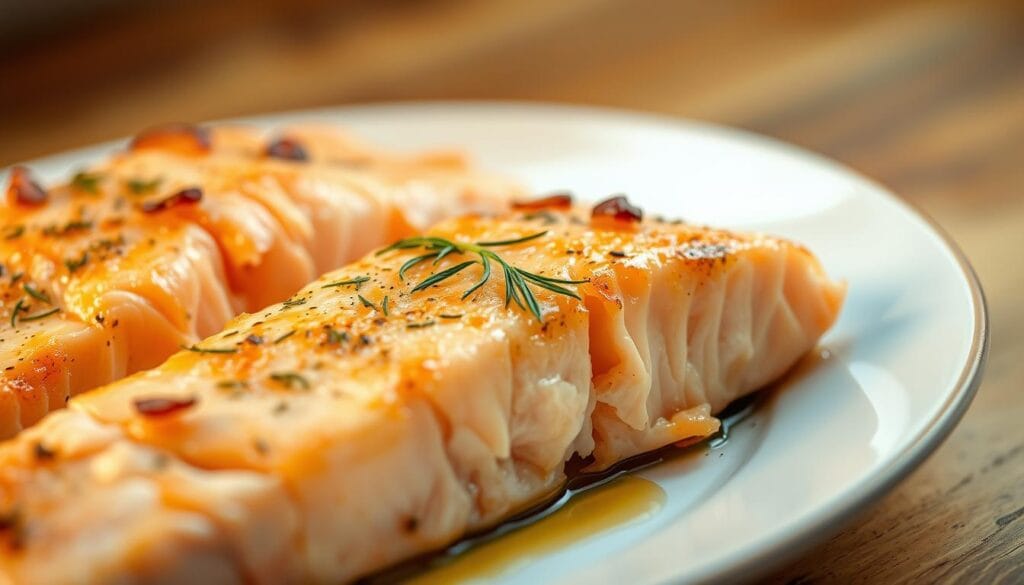
Covering fillets creates a steam pocket. Use foil or parchment paper tents to trap moisture. For extra protection, brush olive oil generously over the surface before seasoning.
Moderate oven temperatures prevent toughness. Bake at 375°F-400°F for gradual cooking. Check internal temps early – removing fish at 140°F lets carryover heat finish the job without drying.
| Method | Moisture Benefit | Best Use |
|---|---|---|
| Skin-On | Natural barrier | Thick cuts |
| Foil Tent | Steam retention | Marinated fillets |
| Oil Coating | Surface protection | Skinless portions |
Fresh herbs like dill or thyme add flavor without salt. Press them into the oiled surface to create a fragrant crust. Let cooked salmon rest 3 minutes – this redistributes juices evenly.
Small adjustments make big differences. Position fillets skin-side down on the tray. Use lemon slices as edible moisture pads. These simple ways transform good fish into exceptional meals.
Delicious Sides and Serving Suggestions
Transform your salmon into a complete dining experience with thoughtful pairings. The right accompaniments highlight the fish’s richness while adding textural contrast. Let’s explore combinations that turn weeknight meals into memorable feasts.
Vegetable and Starch Pairings
Roasted asparagus caramelizes beautifully alongside citrus-glazed fillets. Toss baby potatoes with olive oil and rosemary for crispy edges. Try these crowd-pleasing options:
| Side Dish | Flavor Profile | Prep Time |
|---|---|---|
| Garlic-Herb Potatoes | Savory, aromatic | 25 minutes |
| Lemon-Garlic Green Beans | Bright, crunchy | 12 minutes |
| Honey-Glazed Carrots | Sweet, earthy | 20 minutes |
Don’t discard sheet pan drippings. Whisk them with Greek yogurt for a tangy sauce. Drizzle over steamed vegetables or use as a dip for crusty bread.
Restaurant-Worthy Presentation
Place fillets diagonally across white plates. Scatter colorful roasted veggies around the edges. Garnish with lemon wedges and fresh dill sprigs.
Layer mashed potatoes as a base for skin-on portions. The crispy texture contrasts with creamy sides. For family-style meals, arrange everything on a wooden board with herb bunches.
Watch our video tutorial for plating techniques. Discover how to stack components vertically or create sauce swirls. Simple touches make your dish Instagram-ready while keeping flavors balanced.
Storing Leftovers and Reheating Techniques
Your culinary masterpiece deserves proper preservation. With smart storage and gentle reheating, yesterday’s salmon becomes today’s gourmet lunch. Follow these methods to maintain texture and flavor integrity.
Proper Storage Methods for Freshness
Transfer cooled fillets to an airtight container within two hours of cooking. Layer parchment paper between portions to prevent sticking. Refrigerate at 34-38°F for up to 3-4 days.
For longer storage, wrap individual pieces in foil before freezing. Use freezer-safe containers labeled with dates. Thaw overnight in the fridge – never at room temperature.
Effective Reheating Tips to Retain Moisture
Revive leftovers in a skillet over low heat. Add a teaspoon of water and cover to create steam. Flip once halfway through for even warming.
Oven reheating works best for larger portions. Place fillets on parchment-lined trays at 275°F for 10-12 minutes. Check internal temps reach 125°F to avoid overcooking.
“Low and slow is the golden rule – rushing the process turns delicate fish into rubber.”
Flake reheated salmon into salads or mix with cream cheese for dips. These techniques keep meals exciting while honoring your initial effort.
Conclusion
Achieving restaurant-quality salmon at home becomes effortless with these tested techniques. Proper prep work—like selecting uniform piece sizes and using fresh garlic—sets the stage for success. Baking at the best temperature (400°F) ensures golden edges without sacrificing moisture.
Your choice of tools matters. Parchment paper prevents sticking while allowing gentle heat circulation. Combine this with quality olive oil and citrus juice for bright, balanced flavor in every bite.
This versatile dish adapts to any occasion. Try new herb blends or pair with seasonal side options. Leftovers stay fresh for three days, perfect for quick lunches.
Now’s the time to trust the process. Grab your ingredients and let the oven work its magic. Share your zesty creations—you’ve got everything needed to make baked salmon a weeknight hero.
FAQ
What’s the best temperature for baking salmon?
Can I use parchment paper instead of foil?
How do I know when salmon is done?
What herbs pair well with baked salmon?
How long can I store leftovers?
Should I bake salmon skin-side up or down?
Can I add a sauce to baked salmon?
What sides complement baked salmon?
Author’s Top Recipe Picks :
- Top 7 Incredible Beef Wellington Recipes You’ll Love
- 3 Perfect beef wellington cut of meat : The Ultimate Guide
- Ground Beef and Ramen: 4 Delicious Comfort Meal
Useful links :
Harvard T.H. Chan School of Public Health – Salmon Nutrition
→ Great source for salmon’s health benefits (omega-3, lean protein)
Link: https://www.hsph.harvard.edu/nutritionsource/food-features/fish/
Seafood Watch (Monterey Bay Aquarium)
→ Recommend sustainable salmon choices
Link: https://www.seafoodwatch.org/
Bon Appétit – How to Bake Salmon Perfectly
→ Reinforces your cooking technique with pro chef tips
Link: https://www.bonappetit.com/story/how-to-cook-salmon-in-the-oven

